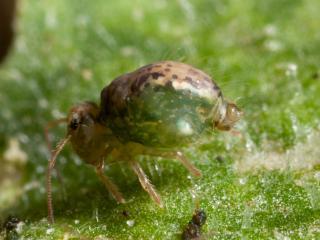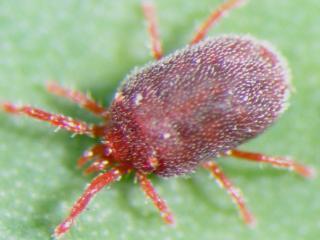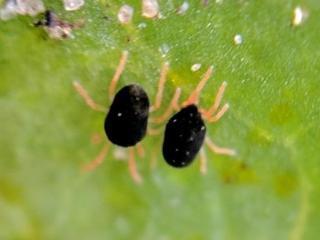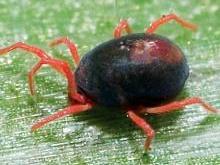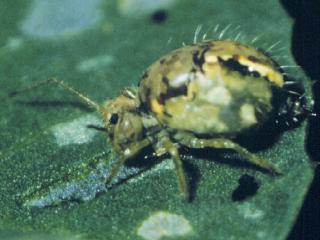Mites and lucerne flea have started hatching
- Mingenew
- Dongara
- Narrogin
- Mount Barker
- Wittenoom Hills
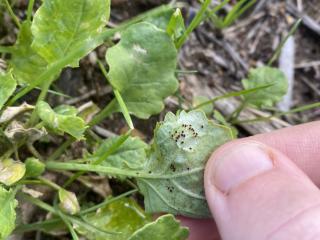
Hilary Wittwer (Wittwer Operations) has reported finding redlegged earth mites (RLEM) on Roundup-Ready (RR) canola volunteers near Narrogin. RLEM have also been observed in the Mount Barker region.
Quenten Knight (Agronomy Focus) recently found Bryobia mites on HyTTec Trophy canola near Wittenoom Hills.
DPIRD staff conducting pitfall trap surveys in the Mingenew and Dongara area have found tiny lucerne flea indicating a recent hatch from eggs in the area. No RLEM were found in traps which supports Cesar Australia’s redlegged earth mite egg hatch calculator which currently predicts “Rainfall and temperature conditions not yet met” for Mingenew and Dongara. However, RLEM egg hatch in the area is probably not far off given that they have hatched at Narrogin.
Growers are reminded that RLEM and lucerne flea have different environmental requirements for hatching of over-summering (i.e. diapause) eggs and the difference in time can be important when considering insecticide application timing and length of efficacy such as post sowing pre-emergent sprays.
As weather conditions continue, it is expected that Balaustium mite will be also present in paddocks and cooler weather will lead to more hatchings of earth mites (blue oat mite and redlegged earth mite).
Correct identification of mites is critical for effective control, as different species can vary in their susceptibility to certain insecticide groups, either naturally or through insecticide resistance. Chemicals applied for control of the wrong pest may result in expensive loss of plant seedling density or having to re-sow some paddocks.
Identification of mites
Adult bryobia mites are reddish-grey with a pie-shaped body, red legs and two long forelegs. For more information refer to DPIRD’s Diagnosing bryobia mite page.
The adult balaustium mite has a brownish / red body and red legs. If viewed under a magnifying glass or microscope it has short, stout, velvety hairs can be seen covering the body. The adult balaustium mite grows to almost twice the size of redlegged earth mites. Several generations can occur each year. For more information refer to the DPIRD Diagnosing balaustium mite page.
Redlegged earth mite (RLEM) adults are 1mm long with a black body and eight red-orange legs. RLEM have a cold temperature requirement (generally seven days below 20°C average daytime temperatures) before the eggs are triggered to hatch. Immature nymphal RLEM are often a more reddish colour than when they are mature. RLEMs do co-exist with blue oat mites so be careful not to incorrectly diagnose the two mites. For more information refer to the DPIRD Diagnosing redlegged earth mite page.
Blue oat mites look similar to RLEM (i.e. adults are 1mm long with eight red-orange legs and have a dark purplish-blue body) but they have a pale to red dot on their back. For more information refer to DPIRD’s Diagnosing blue oat mites page.
Bryobia mites and balaustium mites are more likely to be seen feeding on plants during warm and sunny parts of the day whilst RLEM and blue oat mites will be more noticeable feeding on leaves on overcast cool days or early morning / late afternoon.
You can confirm the identity of mites by using the DPIRD’s PestFacts WA Reporter app.
Predicted hatching dates for redlegged earth mites
RLEM egg hatch often happens on the south coast first then trending northwards given the lower daytime temperatures. However, soil moisture is also an important factor. Cesar Australia has an online RLEM hatch timing tool that uses local climatic data to predict hatch dates, which indicates when to increase crop monitoring. The tool predicts hatchings have occurred from the 13th of April in Katanning and will be occurring from 22nd of April in Esperance. For more information access Cesar Australia’s RLEM hatch tool.
Resistance testing for redlegged earth mites
Growers are urged to keep observe for RLEM activity in their pastures and be aware of insecticide resistant RLEM populations.
Growers and consultants are urged to apply integrated pest management (IPM) strategies when managing RLEM due to cases of insecticide resistance in WA. These strategies include; identifying mites, rotating different chemical groups and reserving co-formulations or chemical mixtures only for situations where damaging levels of RLEM and other insect pests are present.
For more IPM information see DPIRD’s Prevent redlegged earth mite resistance page and GRDC’s Resistance management strategy for the redlegged earth mite in Australian grains and pastures fact sheet.
You can also listen to the recently released DPIRD Grains Convo podcast Why aren’t your insecticides working on redlegged earth mite?
DPIRD, with co-investment from GRDC, will be undertaking RLEM resistance testing this year. If you notice RLEM surviving applications of insecticides please contact DPIRD technical officer Alan Lord or DPIRD research scientist Svetlana Micic to discuss and arrange for paddocks to be tested.
Lucerne flea
The lucerne flea is a Collembolan or 'springtail'. Adult lucerne flea are approximately 3mm in size and green-yellow in colour. Lucerne flea attack a range of crops and pastures, causing characteristic ‘windowing’ of leaves. They work up the plants from ground level, eating tissue from the underside of the foliage. For more information about diagnosing and managing lucerne flea, refer to DPIRD's Diagnosing lucerne flea page.
Management of mites and lucerne flea
Before spraying mites, consider if the crop is out-growing the feeding damage. In many years, and under good growing conditions, mites emerge from eggs during or after crop germination and the plants outgrow mite feeding damage. For more information refer to DPIRD’s Earth mites - economic considerations for management page.
Lucerne flea do not respond well to synthetic pyrethroids such as bifenthrin (e.g. Talstar®) but rather organophosphates (e.g. chlorpyrifos, omethoate) and diafenthriuron (Pegasus®) are registered.
For registered insecticide recommendations for mites and lucerne flea refer to DPIRD’s 2023 autumn winter insecticide guide.
Further information
For more information contact research scientist Svetlana Micic, Albany on +61 (0)8 9892 8591.
Article author(s): Cindy Webster (DPIRD Narrogin) and Svetlana Micic (DPIRD Albany).

